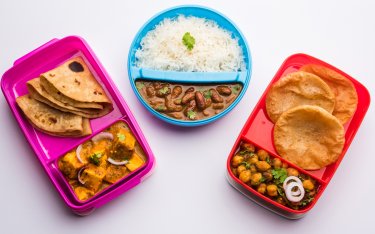Ten years from now, the American school cafeteria may well be unrecognizable. This is due in part to a number of factors already in play: alongside perennial considerations such as funding and supply-chain efficiency are newer and more pressing ones including climate change and the COVID-19 pandemic. It’s enough to make public school administrators trying to design the perfect school lunch feel like they’re jumping through hoops while blindfolded. But as administrators, dietitians and children alike will tell you, student nutrition is anything but child’s play.
Years’ worth of research shows that school lunches significantly impact students’ academic performance, as well as their physical and mental health. Hunger can trigger the release of cortisol and adrenaline, causing aggression and hyperactivity, which can in turn lead to lower grades or even suspensions; it can also make students more susceptible to conditions like asthma and anemia, placing them at higher risk of hospitalization and behavioral issues lasting into adulthood. Children who fall far enough behind in class may need to repeat a grade — this is particularly true of hungry elementary school students — and potentially become socially and academically isolated, making the cycle all the more likely to repeat itself.
Fortunately, many schools have adopted these measures already, with more following suit every quarter. “We’re still going to look at a cup of diverse vegetables a day, half a cup to a cup of fruit a day, low-fat or fat-free dairy, whole grains, meat or meat equivalents; we’re still going to have those base components, and we are definitely moving toward more plant-based center-of-the-plates,” says Kristan Delle, director of food services at the Upper Dublin School District in Pennsylvania. Still, she suggests a recalibration of the ways schools are meeting the necessary standards. Leading this charge are community-based organizations like The Edible Schoolyard Project and events like Junior Iron Chef competitions (whose winners get to see their meal on the school menu), along with a broader shift toward sourcing from local growers and vendors. At the very least, locally decided meals may be a large part of the way forward.
Companies Take Notice
This movement toward more plant-focused food options has not gone unnoticed by U.S. companies, with items like the Jennie-O® Blend Burger now available to consumers. A combination of turkey, black beans, whole grain rice and pepitas, this burger comprises carefully selected and nutritious ingredients that offer consumers the combined benefits of lean, meat-based and plant-forward protein (15g) and fiber (5g) in one tasty turkey burger. The Blend Burger is a sort of gateway patty, perfect for conscious consumers who still eat meat. Renee Cool, brand manager of foodservice at Jennie-O Turkey Store, sees potential in such items. Each school must provide a certain amount of protein, grain, vegetable and fruit, and Renee “could see it being of interest to customers to add a menu item that checks off several meal requirements.” She understands, though, that providing not just alternatives, but innovative options is essential to an improved menu; schools can offer healthy meatless choices to vegetarian students, and iron-rich, meat-centered dishes to students who may be anemic, or at risk of becoming anemic (according to Cedars-Sinai Medical Center, 20 percent of children in the U.S. will be diagnosed with anemia at some point).
Kristen Delle agrees. “We are also definitely looking at offering way more fresh fruits and vegetables, and more culturally diverse foods. Not a caricature of someone’s perception of, say, Chinese food, but true, authentic Chinese food with a school-nutrition spin.” Indeed, these developments are trending across the country.
How fast will this trend catch on? Inevitably, funding and government regulation have a thumb on the scales. Stephen Menyhart, RD, SNS, director of food services at the Boulder Valley School District in Colorado, believes the system has a lot of growing to do. “There will be major global and domestic supply chain issues, which will worsen because of climate change. We need to have contingencies beyond contingencies.” In his view, it’s not a matter of whether school lunches will change, but when.
Local Partnerships Help Improve the Menu
“Over the past ten years, we have been seeing an increase in transportation costs, but the current crisis is completely predicated on COVID,” Delle explains. Local farms and school lunches can work hand-in-hand, one quite literally feeding the success of the other. But with labor shortages due to the pandemic, regional differences in growing seasons and types of produce, and climate change’s tightening grip on agriculture as a whole, there’s never been a more acute need for a localized, collaborative effort to decide what school lunches should look like.
Happily, countless partnerships are already underway. Parents and students are eager to engage with schools in the quest for a menu that’s both appealing and nourishing — and as affordable as possible for their district. Acceptance of diverse and thoughtfully curated menus with plenty of vegetarian and vegan options is on the rise. Even seasoned chefs who leave the restaurant industry in search of a better work-life balance are starting to enjoy the challenge of providing tasty, nutritious food to students.
What’s more, a number of food service directors and other professionals in the field believe that in ten years school lunches will be free, regardless of a student’s family’s income level. “I would be happy if I went the entire rest of my career without hearing anyone refer to a child as a ‘free kid’ again,” says Menyhart, referring to the stigmatizing term for students who receive free or reduced-price meal benefits. “Guess what? Everything in public education is supposed to be free. So that’s my belief and hope, and I think it’s going to be a great equalizer.”

